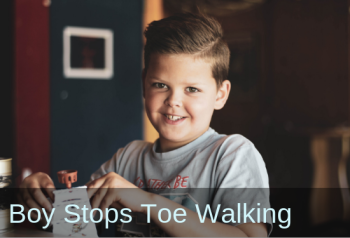No toe walking for the first time after less than a week of rhythmic movements
Submitted by Elissa Cashman, Occupational Therapist

Alex B. is a 5-year-old boy diagnosed with Autism, who attends Kindergarten. Alex is working a year ahead in school in reading and math. However, he was having difficulty with following directions, staying focused, coping with transitions, and performing fine motor/visual motor tasks independently. Alex has also always walked on his toes, and this tendency increased when he became excited or anxious.
In the first sessions, Alex was observed to close his eyes and cover his face, when a ball was gently tossed to him. Alex was able to follow one-step directions, but became quiet and looked down when a challenging task was presented. He was unable to visually track an object, but instead rubbed his eyes and shook his head when presented with the task. Alex had difficulty coordinating his two hands for cutting on a line, and utilized and immature palmar grasp while attempting to copy shapes. Most of Alex’s primitive reflexes were still present upon testing. His difficulty with participating in age-appropriate tasks also directed treatment for reflex integration.
In the first session, Alex required verbal and tactile assist to perform the activities and follow the proper sequence of activities. The Rhythmic Movements [from the Brain and Sensory Foundations course] were introduced to Alex in the first session, as I felt that it would help his overall focus, sensory processing, and higher level skill processing. Alex responded well to the movements, but was eager to finish and play with a toy. I instructed mom on the movements, and the importance of performing them daily. She was going to start with a few minutes a day, and then add time every couple of days, as tolerated.
"Alex’s mom reported that for the first time at home, while cleaning his room, he was walking on his feet, with no toe walking. She had been performing the movements for less than a week."
For the next few sessions, I continued to challenge Alex with developmental movements and games, stimulating his Spinal Galant reflex before play.
Alex participated in isometrics for his hands and feet for the next 3 sessions, and mom was trained in these as well. Mom was also trained in the hedgehog/starfish movement for integration of the Moro reflex. He had difficulty motor planning the Palmar/Babinski isometrics at first, but improved with practice.
In the third session, Alex chose to set a cutting goal for performing a balance. He acted out smoothly cutting on a line, while stabilizing the paper with his helper hand. His Palmar/Babinski reflex was stimulated, as was his ATNR. [After doing movements from the Brain and Sensory Foundations course] Alex then acted out the goal again of smoothly cutting on a line. Alex then sat down to work on cutting some paper strips to make a sun. He was much more relaxed and focused for the activity. His shoulders were more relaxed, and he did a better job of stabilizing the paper. He was able to stay with ¼ inch of the line, for 50% of the cutting task, which was a big improvement. Alex did not complain throughout the task, which was also a positive change
After the first four sessions, and home work of Rhythmic Movements/hand isometrics/feet isometrics/Moro activity, Alex has shown marked improvements. He is transitioning into and out of therapy without difficulty. Mom reports fewer behavioral outbursts at home and at school. His pencil grasp has improved and he more willingly participates in fine motor and visual motor tasks. Alex is now able to participate in 15 minutes of Rhythmic Movements total on most days, per mom report. Alex is now able to catch a gently tossed playground ball, but continues to blink his eyes. He is continuing to work on integrating his reflexes in therapy and participate in Rhythmic Movement with his parents at home. (Emphasis Added)


